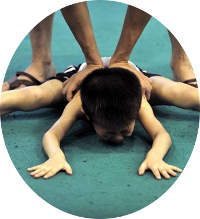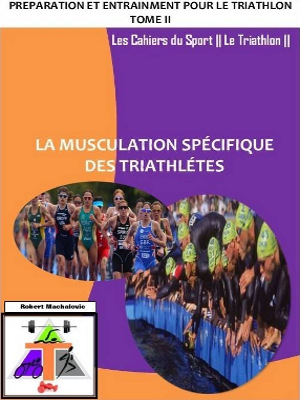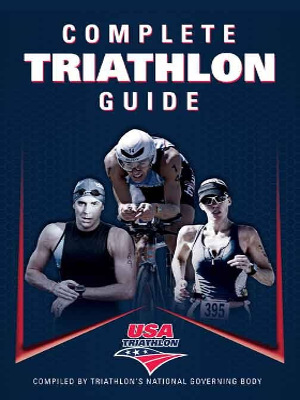Child as an instrument to make parents’ dreams and desires come true.
It is a very frequent phenomenon in training practice. Parents often have the feeling that their offspring should achieve what they themselves never have. This phenomenon is more often manifested in individuale sports such as tennis. The parents’ participating in the competition can then present a crucial stressor for their children.
The above difficulties may occur as early as in the first stage of sports traiing (the stage of being introduced to the sport). Various other negative phenomena occur in sports where the top level is reached in young age, e.g. in gymnastics, figure skating etc.
In children sports training, the coach should tak care to complete the following three priorities:
- 1. Not to harm children physically or psychically. At present, children suffer from specific troubles such as scoliosis, fatique fractures, premature bone ossification etc. due to excessive and unbalanced training load. Likewise, depression or long-term states of frustration may lead to psychic diseases.
- 2. To create a relationship of the children to sport as a whole-life activity. It is not possible for all children to reach the top level. The coach must attempt to make active sporting a whole-life companion for his trainees.
- 3. To create stable foundations for the training in the next age category. Sports training must be focused on managing basic constructions which are necessary for a competition to be carried out. It means teaching children technique, basic rules, basic standards of behavior, tactical procedures necessary to carry out the game; all this in compliance with respective development of motor skills.
Characteristics of the age period between 6 and 18 in children and youth
The division of the age categories is only informational as individual ontogenetic development plays a significant part. Nevertheless, the overview provides a basic insight into the issue of sports preparation.
Younger school age (6-11 years)
- skeleton has not been developed (spine curving), it is necessary to get used to correct body posture
- learning and thinking is focused on individual items, connections are not paid attention to
- personality features are not stable yet, impulsivenes is dominant
- will has not been developed (concentration for maximum of 5 mins)
- the child has mastered basic motor activities (crawling, running, jumping, simple throwing)
- a period sensitive to developing coordination and partial speed
- there are no differences between boys and girls
- the motive of competitivness must be dominant
- game principle prevails in training process
- principle: gradually take children from spontaneous movement to systematic sports preparation includem standards and behavior in sports
- an important point – the example of the coach
- negative assessment from the coach is not suitable
Older school age (11-15 years)
- uneven biological changes (puberty)
- growth is faster as a result of hormones
- increase in sex hormones increases muscle strength significantly, however, tendons, ligaments and tentacles are not yet ready for it
- a feature: motor clumsiness – temporal lost of coordination due to fast growth (13-14 years of age)
- development of logical and abstract thinking
- significant development of emotions
- performance increases naturally
- differences between boys and girls start to be manifested
- bone ossification has still not been completed; this limits efficiency
- a period sensitive to speed development
- endurance development maily through methods of uninterrupted load of low intensity and logner duration
- a highly tactful approach of the coach (the reason being psychic changes in puberty)
Youth age (15-18 years)
- towards the end of this period, physical development of all body organs is slowly completed (heart, lungs, muscles, strengthening bones and tendons)
- full capability of logical thinking, using abstract thinking
- from the age of 16 on, it is possible to increase training requirements more significantly
- the possibility to include anaerobic activities in a greater scope
- the possibility to include systematic strength preparation
- improving detailed technical preparation goes on
- the proportion of tactical preparation increases
- the necessity to regulate psychic conditions of the athletes
The above differentiation is based on calendar year which is only informational and does not inlcude individual speed of ontogenetic changes. Such changes are reflected in biological age. Acceleration means ontogenetic development which is faster than standard. Retardation means the opposite, i.e. ontogenetic development which is slower than standard. Basic methods of determining biological age include:
- Comparing body height and weight with standards.
- Telling the level of bone ossification.
- Telling the level of the development of secondary sexual characteristics.
Sports age is a period during which the athlete is subject to systematic sports preparation. It may be the case that a younger athlete with longer training practice can master sports skills better than much older sportsman.
While creating the conception of sports training, it is necessary to realize that it is a long-term development of performance of each athlete from childhood until adulthood. The contents of the training process must therefore respect biological maturity whereas the biggest performance can be reached only by an athlete who acquired the basis of top performance as early as in childhood and youth. Usually, three kinds of age are differentiated in sports: calendar, biological and sports. Both coaches and athetes must respect all three of them. In this respect, there are two conceptions whic hcan lead to a certain maximum individual efficiency.
- The conception of early specialization.
- The concpetion of training following the age.
Conception of children sports training
Sports training always focuses on characteristic skills for the given sport. The basic difference between the two discussed conceptions is to what extent specific and general stimuli, means and methods contained in the training proces are applied. During the initial years of training, the main aim is not big performance but learning a wide background of motor skills, not only specific movements in the area of the given sport.
Conception of early specialization
This way, a young athlete can reach relatively maximal performance sooner. However, specific load is always a one-sided movement involving the same muscles all the time and there is a danger of muscle imbalance as well as various damages and injuries. Unfinished biological maturing presents a higher probability of health problems. Training specialization is always characteristic in big share of typical (specialized) training means, methods and forms for the given sport. A number of researches on early specialization result in the following:
- An athlete who specializes early proves a steep rise in performance, maximal performance is reached faster.
- High performance during childhood and youth is connected to lower performance after 18 or 19 years of age.
- Athletes who specialized soon have a shorter period of top performance.
- Absolute values of performance (world record) are slightly more often reached by athletes who were subject to a trainingh appropriate for their age.
Still, some kinds of sports (e.g. technical-aesthetic etc.) require early specialization because top performance in these sports is reached prior to the age of 20. A typical example is sports gymnastics where mainly in women, top performances are often reached in childhood – at the ages betwen 14 and 16. Top level sports gymansts of a higher age (over 25) are rather an exception.
Conception of training respective of age
Training respective of the age of a child or youth is interpreted as process respecting their physical and psychical maturity; this process is appropriate for most sports. The advantage of this concept is preventingyoung organism from damage as well as natural sports development. This concept allows keeping top performance for many years during adulthood. The sports life of every athlete must be divided into several stages which are in concordance with their physical and psychic state, maturity, performance development, stages of skill learning etc. We usually divide the sports life of an athlete into four stages:
- Stage of Introductory Sports Pre-Training
- Stage of Basic training
- Stage of Specific training
- Stage of Top training
Stage of Introductory Sports Pre-Training
The main aim is to gain the children for sport and the most important tasks should contribute to their proper physical and psychic development. This stage usually lasts between 1 and 3 years. The prevailing training means and exercises are general, which can help to develop mainly coordinative abilities since the most important task is to teach children as many movement skills as possible. The intensity should be low and volume should be increasing during years of regular training. In this stage, the most effective training means is game.
Stage of Basic training
The main aim is to create permanent positive attitude of children to sport and accepting sport as a part of life style. This stage has to complete several tasks: harmonic development of children and youth, strenghtening health, supporting natural physical and psychic development. Good performance is not a priority and accent is given to further development of coordinative abilities, speed and movement dynamics. The load should be mainly universal and specific load has to be aimed practicing basic technique (children technique) of skills in the given sport. The rate of specific and general training is about 20:80 per cent at the age of 11/12, and 50:50 per cent at the age of 14/15. This stage usually lasts for 2 or 4 years. The age of children going through this stage can vary, however, for most sports; it is usually during older school age. E.g. technical–aesthetic sports (gymnastics, figure skating) start very early (about the age of 5/6), endurance sports can start systematic training later, about the age of 13/14.
Stage of Specific training
The first stage is a transition from basic to specific training. High performance is still a prospective aim, and the competition is not only the criterion of performance but the means of improving performance. The load of training process is increasing (both in volume and intensity). The technical skills are continuously fixed with the help of specific exercises and means, under high load and also with increasing fatigue or in different competition conditions etc. Motor abilities start to develop with respect to the need of specific fitness (specific strength, endurance, velocity).
This stage is typical of every sport and lasts for 2 or 4 years. For most sports, this stage stretches over the category of youth, from 14 (15) to 18(19) years of age. However, in gymnastics, it is approximately between 8 and 12 years (girls). Athletes should understand that their training process is a systematic activity and a meaningful part of their lives.
Stage of Top training
The main aim is to achieve maximal performance and keep it for long time. This stage tops off the long-term training process and it is meant for talented athletes only. Adulthood allows maximal volume and quality of trainings load. In most sports, this stage starts after reaching 19 years of age but in some (technical-aesthetic) sports, the athlete can reach maximal performance early (14 – 18 years). Training volume is very high, 300 – 330 days per year, 700 – 1,500 hour of load. Training process should be adjusted to individual differences among athletes but with maximum focus on specific load, approximately 10-20% of general load and 80-90% of specific load.
The main tasks are: to reach maximal level of technical skills and movement economy, to achieve very high level of tactical abilities, to achieve maximal level of training (strength, endurance, speed etc.).
Specific development of motor abilitities in children training
Logical procedure of developing individual motor abilities is based on the development rules. During life, there are periods which are suitable for developing specific motor abilities – sensitive periods. If coaches make use of such periods, they can form a very good background for future sports life of their athletes. An overview of sensitive periods and specific differences in children training:
Speed abilities
Boys7-14 years of age
Girls7-14 years of age
- It is recommended to develop them together with agility.
- Load interval of 10 seconds.
- Rest interval 1:6.
- In the form of hurdle tracks, fan runs etc.
Endurance abilities
Aerobic endurance whenever
Anearobic endurance from 14-15 years of age on
- In younger school age, hard endurance training does not lead to increase in aerobic performance.
- Until the age of 10, there is no need for special endurance training.
- Endurance training only in adolescence makes sense.
- There is enough time to train anaerobic endurance later.
Strength abilities
Boys13-15 years of age
Girls10-13 years of age
Period till 10 years of age
- The skeleton and muscles are not yet ready for strength development.
- Speed-agility exercise supports strength development themselves.
- The principle of natural muscle strengthening (making use of natural movements, see below).
- All exercise in the form of a game.
- High variability of exercise.
- Means: climbing, wall bar climbing, parallel bars dips, differents hangs, resistance exercises, rope pulling, pushing, exercises with heavy ball (1kg) rolling, carrying etc..
Period between 10 and 12 years of age
- The body is still not prepared yet.
- Focus training on the area of short-time strength exercise.
- Focus on centricity of muscle development, not only on the muscle areas crucial for the specific sports discipline.
- Appropriate method – strength input (including approx. 5-minute units of strength exercise in a different training activity).
- The means now include other exercises, mainly those which make use of the weight of one’s own body: push-ups, squats, sit-ups, exercise with tools (parallel bars push-ups, pull-ups).
Period between 13 and 15 years of age
Period of systematic strength development
The effectivity of individual muscles incereases due to the influence of sex and growth hormons.
Focusing on three basic areas:
- Training strengthening technique
In exercises which focus on handling the axis of a free weight
- General strength training
It is based on methods and means used in previous periods of strength training. Usually in the form of circle procedure. The means mentioned above are made use of together with expanders, light weights etc.
- Using special methods
Applying special methods of strength training (e.g. speed method, effort repetition etc.).
Coordination abilities
Boysuntil 12 years of age
Girls7-11 years of age

 Anyone who performed some sport actively can certainly remember their beginnings and their first coaches. For a child who starts to attend some children sports club at an early age, the figure of the coach means authority. Coaches working with beginning athletes usually determine whether sport shall become part of their entire lives or not. Therefore, the approach and knowledge of the coach is of utmost importance. In children sports training, the coach is faced with many difficulties which he or she must be aware of. The most important difficulties are as follows:
Anyone who performed some sport actively can certainly remember their beginnings and their first coaches. For a child who starts to attend some children sports club at an early age, the figure of the coach means authority. Coaches working with beginning athletes usually determine whether sport shall become part of their entire lives or not. Therefore, the approach and knowledge of the coach is of utmost importance. In children sports training, the coach is faced with many difficulties which he or she must be aware of. The most important difficulties are as follows:


